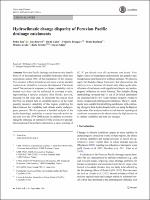Mostrar el registro sencillo del ítem
Hydroclimatic change disparity of Peruvian Pacific drainage catchments
| dc.contributor.author | Rau, P. | |
| dc.contributor.author | Bourrel, L. | |
| dc.contributor.author | Labat, D. | |
| dc.contributor.author | Frappart, F. | |
| dc.contributor.author | Ruelland, D. | |
| dc.contributor.author | Lavado-Casimiro, W. | |
| dc.contributor.author | Dewitte, Boris | |
| dc.contributor.author | Felipe-Obando, Oscar | |
| dc.date.accessioned | 2019-07-07T20:03:35Z | |
| dc.date.available | 2019-07-07T20:03:35Z | |
| dc.date.issued | 2017-08-23 | |
| dc.identifier.citation | Rau, P., Bourrel, L., Labat, D., Frappart, F., Ruelland, D., Lavado, W., … Felipe, O. (2018). Hydroclimatic change disparity of Peruvian Pacific drainage catchments. Servicio Nacional de Meteorología e Hidrología Del Perú– SENAMHI. Retrieved from http://200.10.71.218/handle/senamhi/43 | es_PE |
| dc.identifier.uri | https://hdl.handle.net/20.500.12542/43 | |
| dc.description.abstract | Peruvian Pacific drainage catchments only benefit from 2% of the total national available freshwater while they concentrate almost 50% of the population of the country. This situation is likely to lead a severe water scarcity and also constitutes an obstacle to economic development. Catchment runoff fluctuations in response to climate variability and/or human activities can be reflected in extreme events, representing a serious concern (like floods, erosion, droughts) in the study area. To document this crucial issue for Peru, we present here an insightful analysis of the water quantity resource variability of this region, exploring the links between this variability and climate and/or anthropogenic pressure. We first present a detailed analysis of the hydroclimatologic variability at annual timescale and at basin scale over the 1970–2008 period. In addition to corroborating the influence of extreme El Niño events over precipitation and runoff in northern catchments, a mean warming of 0.2 °C per decade over all catchments was found. Also, higher values of temperature and potential and actual evapotranspiration were found over northern latitudes. We chose to apply the Budyko-Zhang framework that characterizes the water cycle as a function of climate only, allowing the identification of catchments with significant climatic and anthropogenic influence on water balance. The Budyko-Zhang methodology revealed that 11 out of 26 initial catchments are characterized by low water balance disparity related to minor climatic and anthropogenic influence. These 11 catchments were suitable for identifying catchments with contrasting change in their hydroclimatic behavior using the Budyko trajectories. Our analysis further reveals that six hydrological catchment responses can be characterized by high sensitivity to climate variability and land use changes. | es_US |
| dc.description.sponsorship | This work was supported by Peruvian Ministry of Education (MINEDU-PRONABEC scholarship). | es_PE |
| dc.format | application/pdf | es_PE |
| dc.language.iso | eng | es_PE |
| dc.publisher | Springer-Verlag Wien | es_PE |
| dc.relation.ispartof | urn:issn:0177-798X | |
| dc.rights | info:eu-repo/semantics/openAccess | es_PE |
| dc.rights | Reconocimiento - No comercial - Sin obra derivada (CC BY-NC-ND) | es_PE |
| dc.rights.uri | https://creativecommons.org/licenses/by-nc-nd/4.0/ | es_PE |
| dc.source | Servicio Nacional de Meteorología e Hidrología del Perú | es_PE |
| dc.source | Repositorio Institucional - SENAMHI | es_PE |
| dc.subject | Annual variation | en_US |
| dc.subject | Catchment | en_US |
| dc.subject | Cambio Climático | es_PE |
| dc.subject | Climate Variation | en_US |
| dc.subject | Drainage Basin | en_US |
| dc.subject | Hydrological response | en_US |
| dc.subject | Hidrometeorología | es_PE |
| dc.subject | Land use change | en_US |
| dc.subject | Resource scarcity | en_US |
| dc.subject | Timescale | en_US |
| dc.title | Hydroclimatic change disparity of Peruvian Pacific drainage catchments | en_US |
| dc.type | info:eu-repo/semantics/article | es_PE |
| dc.identifier.isni | 0000 0001 0746 0446 | |
| dc.description.peerreview | Por pares | es_PE |
| dc.identifier.doi | https://doi.org/10.1007/s00704-017-2263-x | |
| dc.subject.ocde | https://purl.org/pe-repo/ocde/ford#1.05.11 | es_PE |
| dc.subject.sinia | fenomeno El Niño - Clima y Eventos Naturales | es_PE |
| dc.type.sinia | text/publicacion cientifica | es_PE |
| dc.identifier.url | https://hdl.handle.net/20.500.12542/43 | |
| dc.identifier.url | https://hdl.handle.net/20.500.12542/43 |
Ficheros en el ítem
Este ítem aparece en la(s) siguiente(s) colección(es)
-
Artículo científico [176]








